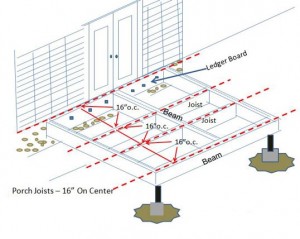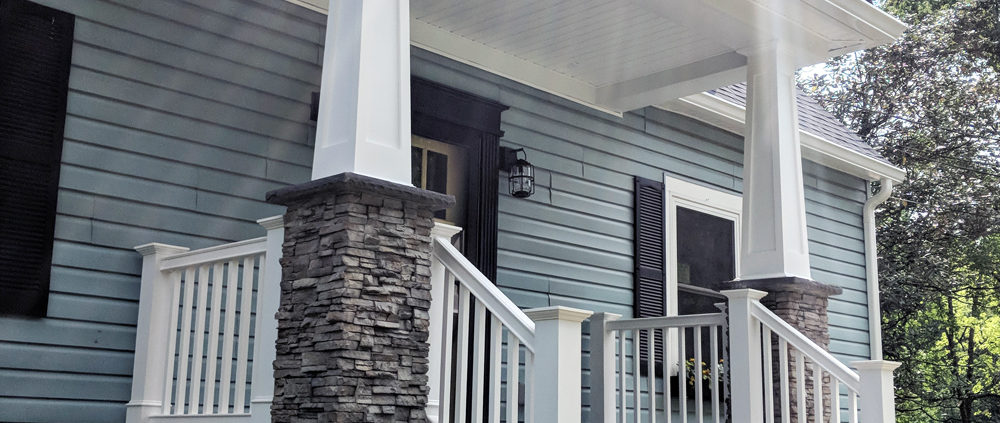Porch Remodels Start With the Foundation
Porch remodels are fairly straightforward; however, it pays to understand how the different components are installed and the many options you have.
Porch foundations aren’t that much different than foundations for homes. A foundation has to safely bear not only the weight of the porch substructure but also the roof, railings, columns, and more.
Before building your front porch, consider the following:
- Geography: Where do you live? Unstable water or soil conditions may require deeper porch footings, thicker walls, or reinforced concrete. (Silty-clay soils, as an example, have an extremely poor load-bearing capacity). In addition, if you live in areas with prominent frost heaves (which have tremendous force) footings must be placed below the frost line.
- Weight: How much does your porch structure weigh? The foundation must be strong enough to support its weight and the weight of your furniture and guests. We’ve all heard of accidents where a deck gave out because there were too many people on it.
- Slopes: Foundation construction is also determined by the slope of the area. Flat areas or very slightly sloped areas still need a good foundation. Even if you have a patio porch, the slab still needs to be stable. Any shifting of the roof can cause considerable damage to the home.
In addition, regardless of the slope, always build to ensure water runs away from the structure. Soil composition is also important and will dictate how deep your footings need to be. For steep slopes, you will need piers — columns of reinforced concrete that sit on concrete slabs deep within the ground — or perhaps even an engineered foundation.
Anatomy of Footings and Pier Foundations
Most porch foundations consist of short columns of either concrete block or poured concrete (piers) that rest on concrete pads called footings. Often these are poured as one unit. Typically, wood posts are then anchored to the pier,s which in turn support beams that are attached to the posts.
Footings
Footings carry the weight of the porch directly onto the soil. Depending on your specific geographical location, footings must be a minimum distance below grade to extend beyond the frost line and be sufficient in size to spread the load. The load includes the weight of your structure (known as the dead load) and people, furniture, and snow (known as the live load).
When building footings, consider the total weight they will carry. If you are planning to install heavy objects like hot tubs, stone fireplaces, etc., be sure to address this with your codes department or a construction engineer before you pour your footings.
Piers
Like decks, piers are an essential part of porch foundations. Piers are short concrete columns on top of footings that support posts. Piers, which are normally below grade, are meant to transfer porch loads to the footings. In the photo below, footings and piers are poured simultaneously. A piece of Sonotube — a form constructed from a heavy-duty cardboard material — is used to create a compact, smooth-sided column for the pier.
Posts
Typically, posts are usually treated 4x4s, 4x6s, or 6x6s. As a general rule, concrete and wood don’t mix so I almost always try to avoid mixing the two, i.e., placing my posts directly into or onto concrete.

You could also choose to space them 12 or 24 inches apart. (If you space them 24 inches apart you may need to add bridging to keep the platform from swaying). The closer together, the more stable your platform. Check with your local codes department to determine specific requirements for your area.
Deck and Porch Construction with Ayars
Laying the proper groundwork for a porch or deck requires doing your homework — from knowing your local building codes to choosing the right materials, not to mention planning and design. If that sounds like too much for you, don’t despair — the team at Ayars Complete Home Improvements is well-versed in all the ins and outs of creating the ultimate outdoor living space. Contact us to see if we’re the right fit for one another.




